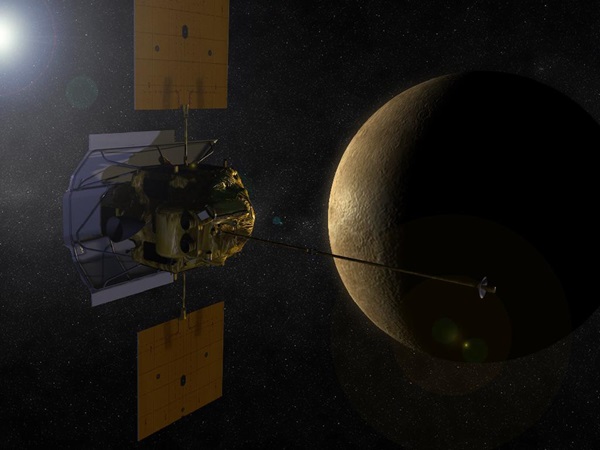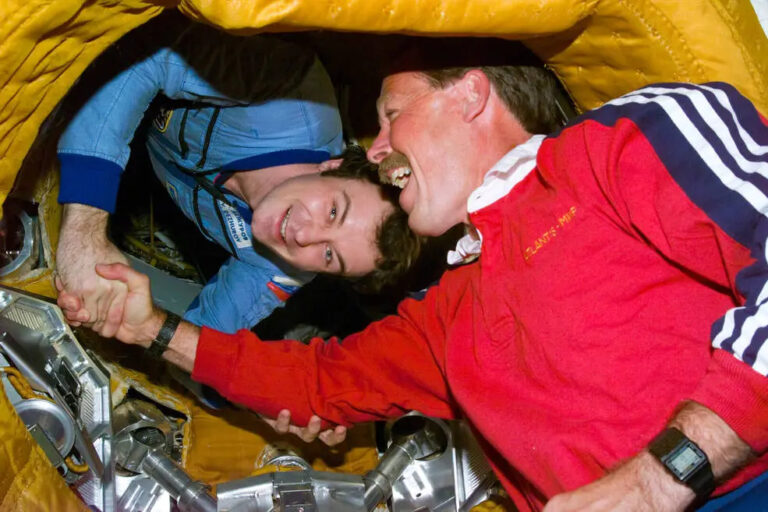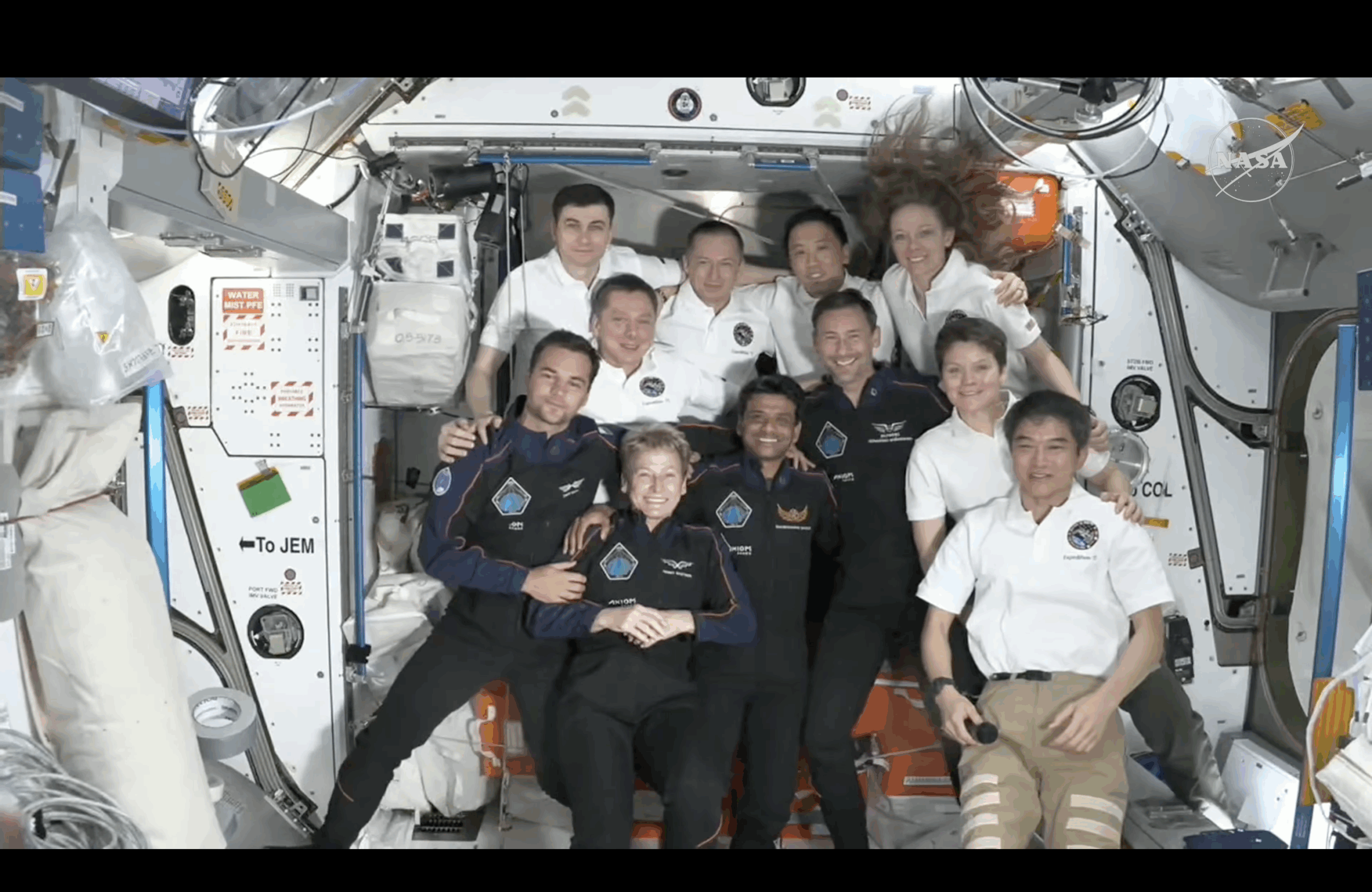After more than a dozen laps through the inner solar system, NASA’s MESSENGER spacecraft will move into orbit around Mercury on March 17, 2011. The durable spacecraft — carrying seven science instruments and fortified against the blistering environs near the Sun — will be the first to orbit the innermost planet.
At 8:45 p.m. EDT, MESSENGER — having pointed its largest thruster very close to the direction of travel — will fire that thruster for nearly 14 minutes, with other thrusters firing for an additional minute, slowing the spacecraft by 1,929 mph (862 meters per second) and consuming 31 percent of the propellant that the spacecraft carried at launch. Less than 9.5 percent of the usable propellant at the start of the mission will remain after completing the orbit insertion maneuver, but the spacecraft will still have plenty of propellant for future orbit correction maneuvers.
The orbit insertion will place the spacecraft into a 12-hour orbit about Mercury with a 124-mile (200 kilometers) minimum altitude. At the time of orbit insertion, MESSENGER will be (28.67 million miles (46.14 million km) from the Sun and 96.35 million miles (155.06 million km) from Earth.
MESSENGER has been on a 6-year mission to become the first spacecraft to orbit Mercury. The spacecraft followed a path through the inner solar system, including one flyby of Earth, two flybys of Venus, and three flybys of Mercury. This impressive journey is returning the first new spacecraft data from Mercury since the Mariner 10 mission more than 30 years ago.
On March 7, antennas from each of the three Deep Space Network (DSN) ground stations began continuous monitoring, allowing flight control engineers at the Johns Hopkins University Applied Physics Laboratory to observe MESSENGER on its final approach to Mercury. The spacecraft also began executing the last cruise command sequence of the mission, when the command sequence containing the orbit-insertion burn will start.
“This is a milestone event for our small, but highly experienced, operations team, marking the end of 6½ years of successfully shepherding the spacecraft through six planetary flybys, five major propulsive maneuvers, and 16 trajectory-correction maneuvers, all while simultaneously preparing for orbit injection and primary mission operations,” said MESSENGER Systems Engineer Eric Finnegan. “Whatever the future holds, this team of highly dedicated engineers has done a phenomenal job methodically generating, testing, and verifying commands to the spacecraft, getting MESSENGER where it is today.”
“The cruise phase of the MESSENGER mission has reached the end game,” adds MESSENGER Principal Investigator Sean Solomon, of the Carnegie Institution of Washington. “Orbit insertion is the last hurdle to a new game level, operation of the first spacecraft in orbit about the solar system’s innermost planet. The MESSENGER team is ready and eager for orbital operations to begin.”
To learn more about the MESSENGER mission, pick up the April 2011 issue of Astronomy, on newsstands now.
After more than a dozen laps through the inner solar system, NASA’s MESSENGER spacecraft will move into orbit around Mercury on March 17, 2011. The durable spacecraft — carrying seven science instruments and fortified against the blistering environs near the Sun — will be the first to orbit the innermost planet.
At 8:45 p.m. EDT, MESSENGER — having pointed its largest thruster very close to the direction of travel — will fire that thruster for nearly 14 minutes, with other thrusters firing for an additional minute, slowing the spacecraft by 1,929 mph (862 meters per second) and consuming 31 percent of the propellant that the spacecraft carried at launch. Less than 9.5 percent of the usable propellant at the start of the mission will remain after completing the orbit insertion maneuver, but the spacecraft will still have plenty of propellant for future orbit correction maneuvers.
The orbit insertion will place the spacecraft into a 12-hour orbit about Mercury with a 124-mile (200 kilometers) minimum altitude. At the time of orbit insertion, MESSENGER will be (28.67 million miles (46.14 million km) from the Sun and 96.35 million miles (155.06 million km) from Earth.
MESSENGER has been on a 6-year mission to become the first spacecraft to orbit Mercury. The spacecraft followed a path through the inner solar system, including one flyby of Earth, two flybys of Venus, and three flybys of Mercury. This impressive journey is returning the first new spacecraft data from Mercury since the Mariner 10 mission more than 30 years ago.
On March 7, antennas from each of the three Deep Space Network (DSN) ground stations began continuous monitoring, allowing flight control engineers at the Johns Hopkins University Applied Physics Laboratory to observe MESSENGER on its final approach to Mercury. The spacecraft also began executing the last cruise command sequence of the mission, when the command sequence containing the orbit-insertion burn will start.
“This is a milestone event for our small, but highly experienced, operations team, marking the end of 6½ years of successfully shepherding the spacecraft through six planetary flybys, five major propulsive maneuvers, and 16 trajectory-correction maneuvers, all while simultaneously preparing for orbit injection and primary mission operations,” said MESSENGER Systems Engineer Eric Finnegan. “Whatever the future holds, this team of highly dedicated engineers has done a phenomenal job methodically generating, testing, and verifying commands to the spacecraft, getting MESSENGER where it is today.”
“The cruise phase of the MESSENGER mission has reached the end game,” adds MESSENGER Principal Investigator Sean Solomon, of the Carnegie Institution of Washington. “Orbit insertion is the last hurdle to a new game level, operation of the first spacecraft in orbit about the solar system’s innermost planet. The MESSENGER team is ready and eager for orbital operations to begin.”
To learn more about the MESSENGER mission, pick up the April 2011 issue of Astronomy, on newsstands now.










